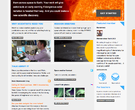Solar Stormwatch
Cs Portal > List of citizen science projects > Solar Stormwatch - (2013/11/14)
IDENTIFICATION
- Beta start date : N/A
- End date :
- Natural sciences > astronomy, astrophyics (space)
- Others in the same subject areas: Air Quality with Biomarkers, Andromeda Project, Bat detective, Budburst... further results
- Others projects about space: Andromeda Project, Galaxy Zoo, Space Warps, The Milky Way Project
⇳ Description Explore interactive diagrams to learn about the Sun and the spacecraft monitoring it. The STEREO spacecraft is scientists’ latest mission to study the Sun and space weather – not clouds and rain, but how solar storms change conditions in space and on Earth. ➠ Purpose The reason that we want lots of people doing this is because that takes away the subjectivity. If we have a consensus view of what a CME looks like and which way it's going then you can be much more confident about that answer being correct. ? Research question The STEREO Mission itself has several big questions that it’s trying to answer. We know that the Sun kicks out these vast solar storms. Each one of these storms is a billion tons of material traveling at a million miles an hour, so they’re not inconsequential. But nobody quite knows why they happen, what causes them to be triggered. For the first time with STEREO, we are actually being able to track these storms continuously all the way from the Sun right out to the Earth from a position which is not near the Earth. So we are actually able to stand back and look at the storm coming from a distance. We want to really start building a space weather forecast from this. Just studying one event doesn't tell you very much about the Sun's behavior in general. What we want to know about is, okay, we understand maybe in detail one event, but what does it do for the next 200 times? Is it the same? Does it change? Does it get progressively more active as the sun gets active? Do they get progressively weaker? Do they get faster? Do they get slower? Do they go off in a particular direction? All these questions need you to have lots of numbers, and we need as many numbers as we possibly can.
TEAM
Royal Observatory Greenwich
Project team page http://www.solarstormwatch.com/mission briefing Leader: Chris Davis Institution: STFC Rutherford Appleton Laboratory Partner institutions: Royal Observatory Greenwich, Zooniverse Contact: http://www.solarstormwatch.com/talk about it
USER TASKS
CONTRIBUTION TYPE: data analysis, data interpretation
PARTICIPATION TYPOLOGY:
GAMING GENRE NONE
GAMING ELEMENTS: NONE
◉ Tasks description
⤯ Interaction with objects Play video, mark beginning and ending of storms, mark extent of storm across camera. ▣ Interface
- Data type to manipulate: pictures
- interface enjoyment: somewhat cool/attractive
- Interface usability: rather easy to use
GUIDANCE
- Tutorial: ✓
- Peer to peer guidance: x
- Training sequence: x
- Individual performance: ✓
- Collective performance: Somewhat
- Research progress: Somewhat
❂ Feedback and guidance description
COMMUNITY
- Main news site:
- Frequency of project news updates: N/A
- Type of events:
- Frequency of events :
⏣ Community description
- Community size (volounteers based)
- Role:
- Interaction form:
- Has official community manager(s): N/A
- Has team work N/A
- Other:
- Community led additions:
Other information
PROJECT
Url:http://www.solarstormwatch.com/
Start date:
End date:
Infrastructure: Zooniverse
TEAM
Official team page:http://www.solarstormwatch.com/mission_briefing
Leader: Chris Davis
Institution: STFC Rutherford Appleton Laboratory
Partner institutions: Royal Observatory Greenwich, Zooniverse
Contact: http://www.solarstormwatch.com/talk_about_it
Main location: Royal Observatory Greenwich
PROJECT DEFINITION
Subject
Natural sciences > astronomy, astrophyics (space)
Description
Explore interactive diagrams to learn about the Sun and the spacecraft monitoring it. The STEREO spacecraft is scientists’ latest mission to study the Sun and space weather – not clouds and rain, but how solar storms change conditions in space and on Earth.
Purpose.
The reason that we want lots of people doing this is because that takes away the subjectivity. If we have a consensus view of what a CME looks like and which way it's going then you can be much more confident about that answer being correct.
Research question.
The STEREO Mission itself has several big questions that it’s trying to answer. We know that the Sun kicks out these vast solar storms. Each one of these storms is a billion tons of material traveling at a million miles an hour, so they’re not inconsequential. But nobody quite knows why they happen, what causes them to be triggered. For the first time with STEREO, we are actually being able to track these storms continuously all the way from the Sun right out to the Earth from a position which is not near the Earth. So we are actually able to stand back and look at the storm coming from a distance. We want to really start building a space weather forecast from this. Just studying one event doesn't tell you very much about the Sun's behavior in general. What we want to know about is, okay, we understand maybe in detail one event, but what does it do for the next 200 times? Is it the same? Does it change? Does it get progressively more active as the sun gets active? Do they get progressively weaker? Do they get faster? Do they get slower? Do they go off in a particular direction? All these questions need you to have lots of numbers, and we need as many numbers as we possibly can.
ABOUT PARTICIPANT TASKS
.
Interaction with system objects.
Play video, mark beginning and ending of storms, mark extent of storm across camera.
| Grey typology | Participation typology | Contribution type: | ||||||||||||||||||||||||||||
|---|---|---|---|---|---|---|---|---|---|---|---|---|---|---|---|---|---|---|---|---|---|---|---|---|---|---|---|---|---|---|
|
|
|
||||||||||||||||||||||||||||
| Gaming | ||||||||||||||||||||||||||||||
| Genre: | Gaming elements: achievements, reward batches | |||||||||||||||||||||||||||||
| Interface | ||||||||||||||||||||||||||||||
| Data type to manipulate: pictures | interface enjoyment: somewhat cool/attractive Interface usability: rather easy to use |
Member profiles::minimal Member profile elements: |
||||||||||||||||||||||||||||
ABOUT GUIDANCE AND FEEDBACK
| Guidance | Feedback on | ||||||||||||
|---|---|---|---|---|---|---|---|---|---|---|---|---|---|
|
|
.
COMMUNITY
| Tools | News & Events |
|---|---|
|
Communication: blog, forum |
Main news site: |
| Community description | |
|
Community size (volounteers based): |
|
Other information about community:
Community led additions:
OTHER PROJECT INFORMATION
Capture d’écran 2013-11-14 à 14.43.41.png No
http://www.solarstormwatch.com/mission briefing
Royal Observatory Greenwich http://www.solarstormwatch.com/talk about it
No astronomy, astrophyics Natural sciences space The reason that we want lots of people doing this is because that takes away the subjectivity. If we have a consensus view of what a CME looks like and which way it's going then you can be much more confident about that answer being correct. The STEREO Mission itself has several big questions that it’s trying to answer. We know that the Sun kicks out these vast solar storms. Each one of these storms is a billion tons of material traveling at a million miles an hour, so they’re not inconsequential. But nobody quite knows why they happen, what causes them to be triggered. For the first time with STEREO, we are actually being able to track these storms continuously all the way from the Sun right out to the Earth from a position which is not near the Earth. So we are actually able to stand back and look at the storm coming from a distance. We want to really start building a space weather forecast from this. Just studying one event doesn't tell you very much about the Sun's behavior in general. What we want to know about is, okay, we understand maybe in detail one event, but what does it do for the next 200 times? Is it the same? Does it change? Does it get progressively more active as the sun gets active? Do they get progressively weaker? Do they get faster? Do they get slower? Do they go off in a particular direction? All these questions need you to have lots of numbers, and we need as many numbers as we possibly can.
Solar Stormwatch
data analysis, data interpretation
pictures, other:
Thinking: no
Computing: no
Sensing: no
Gaming: no
achievements, reward batches
Play video, mark beginning and ending of storms, mark extent of storm across camera. somewhat cool/attractive rather easy to use yes no no yes N/A N/A
minimal
N/A blog, forum Twitter, other
N/A
N/A
Bibliography
| BIBLIOGRAPHY |



